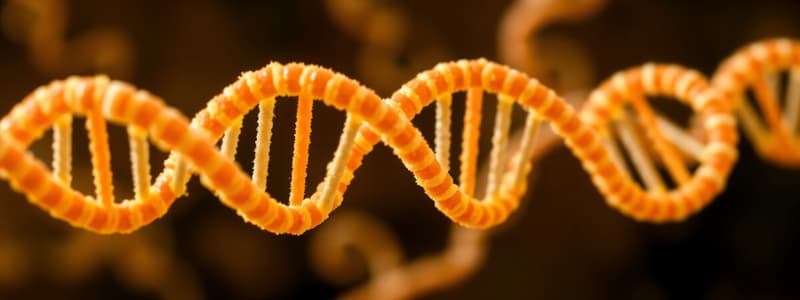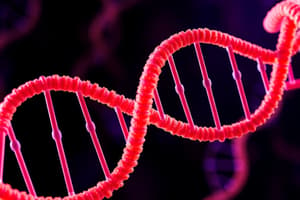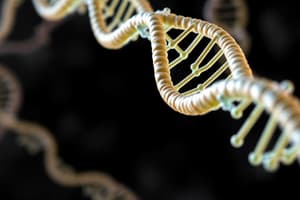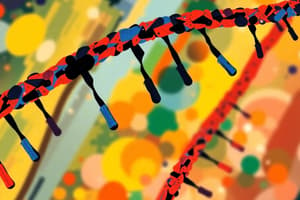Podcast
Questions and Answers
Which of the following processes directly involves RNA polymerase?
Which of the following processes directly involves RNA polymerase?
- Reverse transcription
- DNA replication
- Transcription (correct)
- Translation
During DNA replication, what is the role of the enzyme DNA ligase?
During DNA replication, what is the role of the enzyme DNA ligase?
- To unwind the DNA double helix
- To add nucleotides to the 3' end of the leading strand
- To synthesize short RNA primers
- To seal the gaps between Okazaki fragments (correct)
Which of the following is a key difference between DNA replication and transcription?
Which of the following is a key difference between DNA replication and transcription?
- Replication copies the entire genome, while transcription copies only specific genes. (correct)
- Replication occurs in the nucleus, while transcription occurs in the cytoplasm.
- Replication uses RNA nucleotides, while transcription uses DNA nucleotides.
- Replication involves proofreading mechanisms, while transcription does not.
What is the function of ribosomes in the process of translation?
What is the function of ribosomes in the process of translation?
Which of the following modifications is typically found on eukaryotic mRNA before it leaves the nucleus?
Which of the following modifications is typically found on eukaryotic mRNA before it leaves the nucleus?
What is the primary function of the Origin Recognition Complex (ORC) in DNA replication?
What is the primary function of the Origin Recognition Complex (ORC) in DNA replication?
Why are replication forks considered asymmetrical?
Why are replication forks considered asymmetrical?
During DNA replication, what is the role of the sliding clamp protein, PCNA?
During DNA replication, what is the role of the sliding clamp protein, PCNA?
What is the function of topoisomerase during DNA replication?
What is the function of topoisomerase during DNA replication?
Which statement best describes the key difference between DNA replication on the leading and lagging strands?
Which statement best describes the key difference between DNA replication on the leading and lagging strands?
What enzymatic activity is responsible for removing the RNA primers during DNA replication?
What enzymatic activity is responsible for removing the RNA primers during DNA replication?
What is the role of DNA ligase in DNA replication?
What is the role of DNA ligase in DNA replication?
What is the significance of telomeres in DNA replication?
What is the significance of telomeres in DNA replication?
During mRNA transcription, what is the role of the transcription factors?
During mRNA transcription, what is the role of the transcription factors?
Which of the following is NOT a stage of transcription?
Which of the following is NOT a stage of transcription?
Which enzyme is responsible for synthesizing mRNA during transcription?
Which enzyme is responsible for synthesizing mRNA during transcription?
What is the function of the poly(A) tail added during post-transcriptional processing of pre-mRNA?
What is the function of the poly(A) tail added during post-transcriptional processing of pre-mRNA?
What happens to RNA polymerase II after it receives the signal to end transcription?
What happens to RNA polymerase II after it receives the signal to end transcription?
What is the role of helicase in the initiation of mRNA transcription?
What is the role of helicase in the initiation of mRNA transcription?
The pre-initiation complex (PIC) is essential for transcription. Which components combine to form the PIC?
The pre-initiation complex (PIC) is essential for transcription. Which components combine to form the PIC?
What is the direction of DNA synthesis during replication?
What is the direction of DNA synthesis during replication?
Which enzyme is responsible for unwinding the DNA double helix?
Which enzyme is responsible for unwinding the DNA double helix?
What type of bond joins newly added nucleotides during DNA replication?
What type of bond joins newly added nucleotides during DNA replication?
Which of the following proteins acts as a scaffold during DNA replication?
Which of the following proteins acts as a scaffold during DNA replication?
Which polymerase is primarily responsible for lagging strand synthesis?
Which polymerase is primarily responsible for lagging strand synthesis?
What major role does RNAse H play in DNA replication?
What major role does RNAse H play in DNA replication?
How does DNA polymerase ensure the accuracy of DNA replication?
How does DNA polymerase ensure the accuracy of DNA replication?
What process occurs during the initiation stage of DNA replication?
What process occurs during the initiation stage of DNA replication?
Which of the following describes the role of topoisomerase in DNA replication?
Which of the following describes the role of topoisomerase in DNA replication?
What is the primary role of ribosomes during translation?
What is the primary role of ribosomes during translation?
Which type of tRNA is involved in the initiation stage of translation?
Which type of tRNA is involved in the initiation stage of translation?
What is the primary function of the FEN1 protein in DNA replication?
What is the primary function of the FEN1 protein in DNA replication?
What is the requirement for a DNA polymerase to initiate DNA synthesis?
What is the requirement for a DNA polymerase to initiate DNA synthesis?
What does the presence of a STOP codon signal during translation?
What does the presence of a STOP codon signal during translation?
What are the three main stages of translation?
What are the three main stages of translation?
What defines an origin of replication?
What defines an origin of replication?
What is the main function of the polymerase α/primase complex?
What is the main function of the polymerase α/primase complex?
Which site on the ribosome is responsible for the binding of the newly arriving aminoacyl-tRNA?
Which site on the ribosome is responsible for the binding of the newly arriving aminoacyl-tRNA?
What is a replicon?
What is a replicon?
What is the function of chaperone proteins in post-translational modifications?
What is the function of chaperone proteins in post-translational modifications?
What type of chemical modification is phosphorylation?
What type of chemical modification is phosphorylation?
During translation elongation, which enzyme is responsible for forming the peptide bond?
During translation elongation, which enzyme is responsible for forming the peptide bond?
Which component recognizes the first AUG start codon during translation initiation?
Which component recognizes the first AUG start codon during translation initiation?
What happens to the polypeptide chain at the end of translation termination?
What happens to the polypeptide chain at the end of translation termination?
Which of the following correctly describes the components of a pre-initiation complex?
Which of the following correctly describes the components of a pre-initiation complex?
Which factor is NOT necessary for the elongation phase of translation?
Which factor is NOT necessary for the elongation phase of translation?
What is the role of aminoacyl-tRNA synthetase during translation?
What is the role of aminoacyl-tRNA synthetase during translation?
Flashcards
DNA Replication
DNA Replication
The process of copying DNA to create two identical DNA molecules.
Transcription
Transcription
The process of synthesizing RNA from a DNA template.
Translation
Translation
The process in which ribosomes read mRNA to synthesize proteins.
mRNA
mRNA
Signup and view all the flashcards
Ribosomes
Ribosomes
Signup and view all the flashcards
Semiconservative replication
Semiconservative replication
Signup and view all the flashcards
Direction of DNA synthesis
Direction of DNA synthesis
Signup and view all the flashcards
Phosphodiester bond
Phosphodiester bond
Signup and view all the flashcards
Helicase
Helicase
Signup and view all the flashcards
Topoisomerases
Topoisomerases
Signup and view all the flashcards
Replication Protein A (RPA)
Replication Protein A (RPA)
Signup and view all the flashcards
RFC
RFC
Signup and view all the flashcards
DNA polymerase
DNA polymerase
Signup and view all the flashcards
Primase
Primase
Signup and view all the flashcards
Exonuclease activity
Exonuclease activity
Signup and view all the flashcards
RNAse H
RNAse H
Signup and view all the flashcards
Ligase
Ligase
Signup and view all the flashcards
Stages of DNA replication
Stages of DNA replication
Signup and view all the flashcards
Replication factories
Replication factories
Signup and view all the flashcards
Pre-replication complex (pre-RC)
Pre-replication complex (pre-RC)
Signup and view all the flashcards
Origin Recognition Complex (ORC)
Origin Recognition Complex (ORC)
Signup and view all the flashcards
Replication fork
Replication fork
Signup and view all the flashcards
Leading strand
Leading strand
Signup and view all the flashcards
Lagging strand
Lagging strand
Signup and view all the flashcards
Okazaki fragments
Okazaki fragments
Signup and view all the flashcards
RNase H and FEN1
RNase H and FEN1
Signup and view all the flashcards
Transcription factors
Transcription factors
Signup and view all the flashcards
RNA polymerase II
RNA polymerase II
Signup and view all the flashcards
Post-transcriptional processing
Post-transcriptional processing
Signup and view all the flashcards
Peptide bond
Peptide bond
Signup and view all the flashcards
Polypeptide chain
Polypeptide chain
Signup and view all the flashcards
Initiation factors
Initiation factors
Signup and view all the flashcards
AUG codon
AUG codon
Signup and view all the flashcards
Stop codons
Stop codons
Signup and view all the flashcards
Translation elongation
Translation elongation
Signup and view all the flashcards
Post-translational modifications
Post-translational modifications
Signup and view all the flashcards
Chaperone proteins
Chaperone proteins
Signup and view all the flashcards
Peptidyl transferase
Peptidyl transferase
Signup and view all the flashcards
tRNA binding sites
tRNA binding sites
Signup and view all the flashcards
Release factors
Release factors
Signup and view all the flashcards
Aminoacyl-tRNA synthetase
Aminoacyl-tRNA synthetase
Signup and view all the flashcards
Study Notes
DNA Replication, Transcription and Translation
- DNA Replication: A semiconservative process where each strand of the DNA double helix serves as a template for a new, complementary strand. DNA synthesis proceeds only in the 5' to 3' direction. This enzymatic process requires numerous protein complexes and energy input from the hydrolysis of high-energy phosphate bonds.
Book Reference
- Use Essential Cell Biology, 6th edition by Bruce Alberts, focusing on content covered in the lectures.
- Refer to Chapter 6: DNA Replication and Repair.
- Refer to Chapter 7: From DNA to Protein.
DNA Replication Proteins
- Helicase (MCM 2-7): A protein complex forming a ring around a single DNA strand and breaking hydrogen bonds between complementary bases to unwind the DNA. The MCM 2-7 proteins use ATP.
- Topoisomerases (I and II): Enzymes that change topology of the DNA strand by reducing tension from the unwinding of the DNA helix.
- Replication Protein A (RPA): Binds to single stranded DNA segments, preventing the formation of hydrogen bonds and allowing DNA polymerase to synthesize a complementary DNA strand.
- Proliferating Cell Nuclear Antigen (PCNA): A ring-shaped homotrimer placed on the DNA strand with the participation of RFC. PCNA acts as a scaffold for recruitment of proteins involved in DNA replication, repair, chromatin remodeling, and epigenetic regulation. PCNA protects DNA polymerase from detaching and releases the DNA polymerase after each Okazaki fragment is synthesized.
- Replication Factor C (RFC): A ring-applying protein that opens the PCNA protein trimer, introduces DNA into the center of the ring, and then closes the ring using ATP. RFC is involved in leading and lagging strand replication, where PCNA is placed multiple times on the DNA strand on the lagging strand synthesis due to Okazaki fragments.
- DNA Polymerases (α, β, γ, δ, ε): Enzymes involved in DNA synthesis. DNA Polymerases δ (d) and ε (e) are composed of four subunits with specific molecular weights. Polymerase δ prefers leading strand replication, and Polymerase ε prefers lagging strand replication. Both polymerases exhibit 5' to 3' polymerase and 3' to 5' exonuclease activity.
- RNase H (endonucleases): Removes RNA primers, except for the last ribonucleotide in the DNA chain.
- FEN1 (exonuclease): Removes the last ribonucleotide of the iRNA primer.
- Ligase: Joins deoxyribonucleotides to a DNA strand by forming phosphodiester bonds using ATP. Connects Okazaki fragments on the lagging strand.
DNA Polymerase
- Characteristics: Require a DNA template; unable to initiate a new strand independently (need a primer). Possess 5' to 3' polymerase activity and 3' to 5' exonuclease activity (proofreading).
Polymerase a/primase
- Characteristics: Has both primase and DNA polymerase activity. Primase synthesizes a short RNA primer complementary to the template DNA strand. Polymerase a adds a section of DNA to the primer. Polymerases δ and ε then take over further DNA synthesis.
Ribonucleases (RNAses)
- Characteristics: Hydrolases that divide RNA molecules into smaller segments or single nucleotides by hydrolyzing phosphodiester bonds.
- Endoribonucleases: Divide RNA molecules in the middle of the RNA chain.
- Exoribonucleases: Detach nucleotides from the 3' or 5' end of RNA.
Replication Proteins
- RNase H: Removes RNA primers, except for last ribonucleotide, in synthesis of new DNA.
- FEN1: An exoribonuclease that removes the final ribonucleotide from RNA primer.
Limitations of DNA Replication
- Unwinding the DNA double helix: Requires energy and specific proteins (helicases) to prevent strain and maintain the unwound and copied strands.
- DNA polymerase's inability to initiate independent synthesis: A primer (often RNA) is needed to provide a starting point.
- Addition of nucleotides only in the 5' to 3' direction: This creates issues because the DNA strands are antiparallel, leading to continuous and discontinuous synthesis.
Stages of DNA Replication
- Initiation: Recognition of specific sequences (origins of replication) by the pre-replication complex. The specific sequence is 10,000 base pairs in mammals. Forms replication bubbles which then form replication forks. The unwinding of the DNA helix occurs at origins of replication.
- Elongation: The action of replication forks. Copies the parent DNA strands.
- Termination: Completion and assembly of new DNA strands and meeting of the replication forks.
Replication Forks
- Antiparallel arrangement of DNA strands and 5’ → 3’ synthesis means replication forks are asymmetrical. One strand is synthesized continuously (leading strand); the other in sections (lagging strand), called Okazaki fragments.
DNA Replication Elongation
-
Leading strand: Synthesized continuously in the 5' → 3' direction by δ-polymerase in eukaryotic processes.
-
Lagging strand: Synthesized discontinuously (Okazaki fragments). Uses ε-polymerase and has RNA primers. This needs replacement of RNA primers, and joining those fragments.
Transcription
- The process of rewriting genetic information from DNA to RNA (mRNA, tRNA, or rRNA).
- Based on the complementarity rule: base pairing (A-U and C-G).
- Promoter and terminator regions mark the start and end of the transcription unit.
- DNA is read in the 3' → 5' direction.
- RNA is synthesized from 5' to 3' direction by RNA polymerases I, II, or III.
Transcription Stages
- Initiation: Binding of RNA polymerase to a promoter region.
- Elongation: RNA polymerase synthesizes a pre-RNA molecule.
- Termination: RNA polymerase stops synthesizing and releases the pre-RNA.
Initiation of mRNA Transcription
- A complex of two proteins recognizes the promoter and forms a platform for subsequent factors (like helicase) and RNA polymerase II.
- The complex forms a pre-initiation complex that binds the gene promoter, enabling RNA polymerase II to initiate transcription of pre-mRNA.
Elongation of mRNA Transcription
- After elongation begins, most transcription factors detach from the DNA.
- The first step in freeing RNA polymerase II involves adding phosphate groups (phosphorylation) to its "tail".
- More ribonucleotides are added, and the pre-mRNA molecule is synthesized.
Termination of mRNA Transcription
- RNA polymerase II continues transcription until a termination signal (terminator sequence) is encountered.
- Phosphodiester bond formation ceases.
- Pre-mRNA dissociates from the DNA–RNA hybrid, and the unraveled DNA fragment joins.
Post-transcriptional Processing
- Adding a cap to the 5' end.
- Cutting out introns and joining exons (splicing).
- Adding a poly-A tail to the 3' end.
Translation
- The process of synthesizing a polypeptide chain (protein) from an mRNA.
- Takes place in the cytoplasm or on the rough endoplasmic reticulum.
- Catalyzed by the ribosome.
- Consists of synthesis of polypeptide chain according to the information in the DNA fragment; and peptide bond formation between consecutive amino acids.
Ribosome
- Composed of two subunits (small and large), both made of proteins and rRNA.
- Subunits connect for translation.
- The small subunit has an mRNA binding site.
- Both subunits form tRNA binding sites: A (aminoacyl-tRNA), P (peptidyl-tRNA), and E (exit).
Translation Stages
- Initiation: Formation of the pre-initiation complex
- Small ribosomal subunit
- Initiation factors
- Initiator tRNA
- Elongation: A sequence of steps (Stage 1-4) repeated for each amino acid added to the growing polypeptide chain.
- tRNA binds to the A site.
- Peptide bond forms.
- Ribosome moves along the mRNA.
- Termination: The incorporation of STOP codons into the mRNA sequence.
- Release factors bind to the A site.
- Polypeptide chain releases.
Initiator tRNA
- fmet-tRNA and met-tRNA bind methionine.
- fmet-tRNA initiates protein synthesis.
- Only fmet-tRNAf binds the P site in the absence of the large ribosomal subunit.
Attaching tRNA to Amino Acid
- Aminoacyl-tRNA synthetase attaches the correct amino acid to its specific tRNA.
Translation initiation
- No signal sequences on mRNA to help locate start site.
- Pre-initiation complex (small ribosomal subunit, initiator tRNA, and mRNA).
- The complex scans the mRNA for AUG start codon.
- Translation initiation factors detach, large subunit joins the complex, and the first tRNA (initiator tRNA) binds within the P site, where the polypeptide chain will begin to grow.
Translation Elongation
- tRNA carries the next amino acid and binds to the A site, ensuring codon–anticodon base complementarity to maintain the genetic flow.
- Peptide bond formation occurs between the amino acid on site A with the peptide on site P.
- Ribosome moves one codon position along the mRNA.
- tRNA that previously was at site A moves to site P, and the tRNA that was at site P moves to site E (exit).
Termination of Translation
- STOP codon encountered.
- Release factors bind the A site.
- Polypeptide chain is released.
- Ribosome disintegrates into two subunits.
Post-translational modifications
-
Several processes modify proteins after translation to create functional proteins.
- Proteolytic processing: Cutting proteins into smaller units.
- Formation of secondary structure: Folding into specific shapes.
- Protein folding: Using chaperone proteins to help proteins fold properly.
-
Chemical modifications: Phosphorylation of proteins (adding a phosphate group); dephosphorylation (removing a phosphate group).
-
Glycosylation (adding sugar residues), hydroxylation (adding a hydroxyl group), acetylation (adding an acetyl group), methylation (adding a methyl group), and formylation (adding a formyl group).
-
Chaperone are proteins that are involved in the correct folding of proteins. Newly synthesized polypeptide chains bind to these chaperone proteins to correctly fold. If incorrectly folded proteins are present, they can be degraded (broken down into smaller chains of amino acids). Additionally, chaperone proteins can also create isolation chambers in order to facilitate protein folding.
Studying That Suits You
Use AI to generate personalized quizzes and flashcards to suit your learning preferences.





